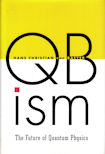Short for Quantum Bayesianism, QBism adapts many of the conventional features of quantum mechanics in light of a revised understanding of probability. Bayesian probability, unlike the standard “frequentist probability,” is defined as a numerical measure of the degree of an observer’s belief that a future event will occur or that a particular proposition is true. Bayesianism’s advantages over frequentist probability are that it is applicable to singular events, its probability estimates can be updated based on acquisition of new information, and it can effortlessly include frequentist results.
But perhaps most important, much of the weirdness associated with quantum theory—the idea that an atom can be in two places at once, or that signals can travel faster than the speed of light, or that Schrödinger’s cat can be simultaneously dead and alive—dissolves under the lens of QBism.
Using straightforward language without equations, Hans Christian von Baeyer clarifies the meaning of quantum mechanics in a commonsense way that suggests a new approach to physics in general.
Quantum mechanics is notoriously unintuitive, with its “collapsing wavefunctions” or “many worlds” or whatever is added as an interpretation to its weird predictions. Yet those predictions belong to the most accurate physical theory known.
Quantum mechanics seems to say we have to give up some cherished notion of the world: if we want locality (no “spooky action at a distance”, only local interactions that propagate), we can’t have realism (the idea that there is some definite thing or process there), and vice versa. Quantum Bayesianism lets go of reality, but in an interesting way.
This brilliant little book takes the reader through a description of the weirdnesses of quantum mechanics, and the interpretation of Bayesian statistics, before applying the latter to the former.
The key idea of Bayesian, as opposed to frequentist, statistics is that probabilities are about our knowledge of the world (we assign a prior probability to a fair coin toss of 50% of landing heads, because we don’t know all the details of the initial spin, the air currents, etc). Bayesianism defines how to update this prior knowledge (the 50/50 chance) with a new probability once we have further data (anything from more knowledge about those initial conditions, to an observation of how the coin actually landed). So in QBism the probabilistic quantum wavefunction is interpreted as our prior knowledge of the system. This gets around “wavefunction collapse”: we just update our prior with the additional observational data. It gets around “Wigner’s friend”: Wigner has one prior wavefunction, his friend, who has observed more of the the situation, has an updated, and therefore different, wavefunction. The wavefunction belongs to the observer, not to the system.
Quantum mechanics allows us to calculate the best possible prior from our knowledge of the system. What makes quantum mechanics weird is that a calculated wave function that says a photon has a 50/50 chance of doing something, say, is the best possible knowledge we can have of the system: unlike in the classical case, it is not possible to improve the prediction by having more data about how it was set up. This is why we have to give up “reality”: the wavefunction isn’t “real”, because it is not a property of the system itself, it is just the best possible description of it. There is no underlying “real” system that “knows” what the actual answer will be (unlike the classical coin toss). Once the photon has interacted with something, the system has changed, and we can update our prior with the new observed data.
This loss of “realism” does not mean QBism denies the existence of a real world “out there”. It instead leads to a startlingly different view of that real world. The world is not a deterministic automaton, set going at the start, trundling along a pre-determined track. It is a world undergoing constant creation by quantum systems (which may include observers) interacting.
von Bayer writes in a very accessible way. I admit, the sections on the delayed choice and the GHZ experiments could have gone more slowly. But overall, the exposition is brilliant: on quantum mechanics, on Bayesianism, and then on the combination. This book changed my world view.
